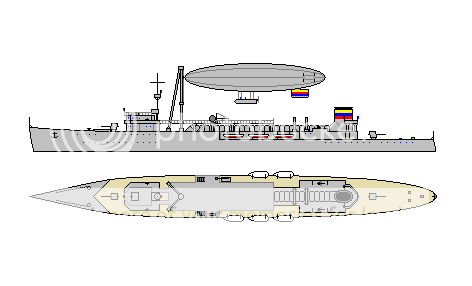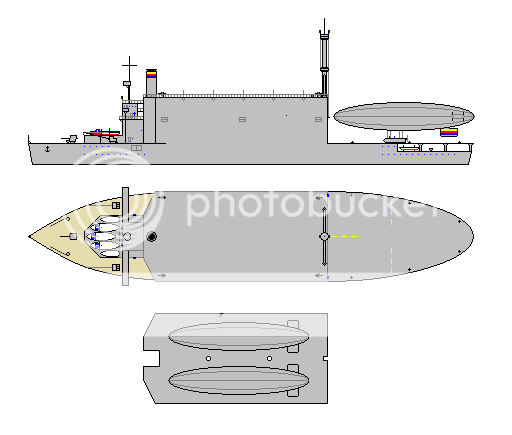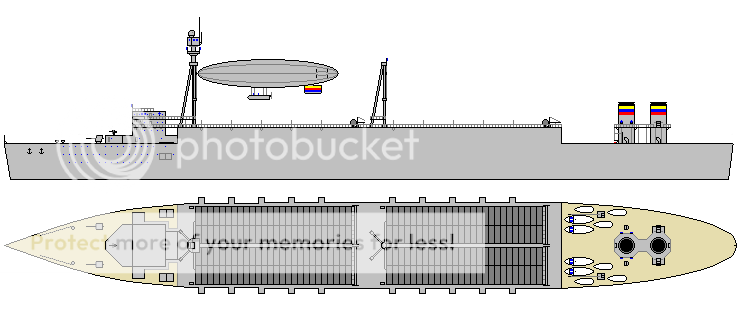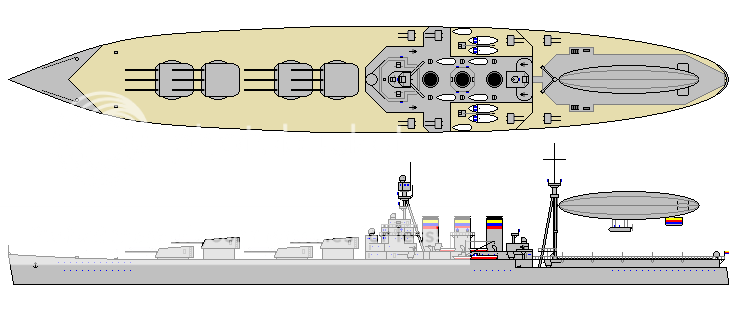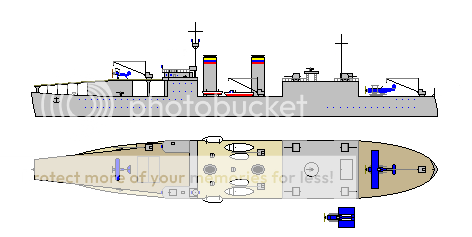Right, I think I got everything down for the most part in designing this class as part of required aspects. The year so far of this design is 2003 (if not already seen and mentioned). I think I might have went overboard on this...
Class Name: John Paul Jones-class
Design Type: Supercarrier
Nation of Origin: United States
Displacement (Empty): 67,000 Tons (As Built) (Standard Design); 69,200 Tons (John S. McCain Sub-Class) (Flight II); 70,700 Tons (As Built) (Arizona Sub-Class)
Design: The John Paul Jones-class Supercarrier, was designed as a replacement for the retiring Essex-class and Midway-class, along with a successor to the Enterprise-class of two nuclear carriers, the USS Enterprise, and USS Nimitz, and the United States-class of two conventional supercarriers, the USS United States and USS Reprisal. In the early seventies, the basic aspect of the design was agreed upon for a CATOBAR style arrangement, but orders for it were delayed, due to the end of the Vietnam War, and the new Fleet Defense Fighter, to compensate for the experience learned in the combat fought there.
The supercarrier class, was designed with increased storage capabilities for ammunition, fuel oil, and aviation fuel compared to the prior design classes, for two primary reasons as outlined. The first primary reason outlined was a lessening aspect of tankers and ammunition resupply ships in the fleet, leaving logistics contracted to the civilian side, and the second primary reason outlined was newer generations of destroyers being built, and brought online, which while more efficient compared to the older World War II-era destroyers, still required more gas than the previous generation of destroyers.
The planned name for the new class of carriers, starting with CVA-71, was debated, with some proposing for it to start with a President, or go with the regular naming scheme. The loss of the USS John Paul Jones (DDG-32), in May of 1973 after the loss of her bow during a failed underway replenishment, leading to her decommissioning and scrapping, gave the Chief of Naval Operations, the possibility to name the next carrier class after one of America's most famous admirals. As such, the CVA-71 class, was officially given the name the John Paul Jones-class on September of 1974, as the final aspects of the design was completed, with an initial plan of six in all, with two to be ordered for Fiscal Year 1975, two for Fiscal Year 1976, and then two for Fiscal Year 1978.
Ships:
Standard Design
USS John Paul Jones (CVA/CV-71)
USS Yorktown (CVA/CV-72)
USS Sable (CVA/CV-73)*
USS Langley (CV-74)
John S. McCain Sub-Class
USS John S. McCain (CV-75)
USS Essex (CV-76)
Arizona Sub-Class
USS Arizona (CV-77)^
USS John Adams (CV-78)^
Intrepid Sub-Class/Class!
USS Intrepid (CV-79)
USS George Washington (CV-80)
*The naming of the third ship in the class after the USS Sable (IX-81), a training carrier, was seen as a somewhat of a controversial move, but supported by members of the Navy, for her role in helping to train the nearly seventeen thousand carrier pilots who would help the Navy during the Second World War.
^ The naming of the final two carriers of the Jones-class to be the Arizona (after the battleship USS Arizona, which was destroyed at Pearl Harbor), and the John Adams (after President John Adams, and one of the earliest pro-Navy presidents), was a controversial decision in the year of 1981, with funding for an additional two John Paul Jones-class carriers allocated, due to the levels of damage from the Midway, due to improper maintenance, and construction seen. Democrats within Congress, supported the move to name the seventh carrier, after the battleship Arizona, lost in the Attack on Pearl Harbor, supported by survivors in the attacks. The issue would raise debate in Congress, with an eventual compromise to name the second ship as part of the two after President John Adams. By this point, both supercarriers were ordered for Fiscal Year 1982.
! The Intrepid 'Class', was designed, based off some of the experiences from the South African Civil War (along with much of the Cold War throughout the 1980s), along with a reported carrier 'shortfall' with the plans to retire additional supercarriers in 1989. The Intrepid 'Class' in addition, was designed to keep the jobs at Newport secure, to prevent a significant financial overrun in the designing of the next class. The first ship, the Intrepid, was laid down in 1993, and being launched in 1996. The second ship, the USS George Washington, was laid down in 1998, and launched by 2001.
History:
The John Paul Jones-class, had the first ship, the USS John Paul Jones, laid down on March 19th, 1975, being launched on July 6th, 1978 (John Paul Jones' two hundredth and forty-first birthday), with commissioning on October 25th, 1979. The John Paul Jones, would be deployed immediately, to the Mediterranean, following a refueling incident with the USS United States, who was planned to replace the USS Saratoga preparing to return home from her deployment. Her air wing, CVW-10, would see its first combat, as two F-14A Tomcats from VF-143 'Pukin Dogs', would shoot down two Libyan Tu-95 Bears, after refusal to vector away from the John Paul Jones, and after a believed firing of an anti-ship missile (according to Captain Collin's report on the incident in question), both Tu-95 Bears would be shot down by AIM-54 Phoenixes.
The second deployment of the USS Sable, lasting from March of 1983 to February of 1984 (the longest deployment so far in the history of the Navy, lasting for a period of eleven months), occurred during the height of the Ussuri River Crisis, in coordination with the USS Kitty Hawk, and the USS Ranger (from December of 1984 to February of 1984 to replace the Kitty Hawk). The Ussuri River Crisis, lasting from April of 1983 to May of 1984, a thirteen month period ignited, with attempts by the President of China to claim that the Damansky Island was Chinese, with threats of war emerging. The Sable, would be harassed by numerous Soviet Bears, Blinders, and Backfires, along with their respective escorts, and the first Akula-class nuclear attack submarines, operating throughout the Sea of Ohkotsh, the Sea of Japan, and the Northern Pacific.
The November 7th Incident, as it was classified, is considered one of the closest points to a Third World War ignition in the 1980s, after the detection of a force of six inbound Soviet Backfire bombers, along with four Blinders, with two early MiG-29s, by an airborne E-2C Hawkeye. In the middle of confirming the inbound contacts with a section of two airborne Tomcats, communications were cut off, and the loss of contact with the Hawkeye known as 'Champion Three.' Per standing orders from Rear Admiral Davey, passed on from COMPACFLT, both Alert Five Tomcats were scrambled, boosting the Combat Air Patrol to a total of six Tomcats out of twenty-six based on the Sable, with another four being readied to be launched if further contacts were detected. The airborne CAP that Champion Three was coordinating with, two Tomcats from VF-32 'Gladiators', call signs of 'Pony Seven' and 'Pony Eight', began readying for combat intercept. Over six minutes, if radar detection had picked up any hints of a vampire launch, any of the four Tomcats vectoring for interception could have fired. It wasn't until Pony Seven confirmed at 14:57 local time, that the AWG-9 radar had confirmed the group of twelve aircraft was vectoring away, and a near readiness for combat had backed down.
The South African Civil War, along with the UN intervention, would see the largest concentration of the John Paul Jones-class supercarrier, with the USS John Paul Jones, USS Langley, and the USS Arizona operating along with the nuclear carrier USS Nimitz, in the initial stages of the US/UN forces against the apartheid government of South Africa. However, over the period from October of 1989 to February of 1991, a total of five John Paul Jones-class supercarriers would support the US/UN forces, consisting of the USS John Paul Jones, USS Langley, USS John S. McCain, USS Arizona, and USS John Adams, with the USS John Adams, being the last carrier to exit the theater, with the end of the direct military intervention present there, and a new government in the process of being established. The USS Langley, would be attacked by South African Mirage F1s, which would succeed in hitting the guided missile cruiser, USS Horne, with a single Exocet anti-ship missile, and a single remaining Mirage F1, out of the strike of twelve, would impact the USS Langley, amidships, equivalent to the kamikazes of World War II. The Langley, would suffer significant damage, and fires from the impact, but would manage to return to Newport News, for heavy repairs. The Langley's repairs, would last a period of nearly thirteen months, due to the extensive damage suffered by fires which included significant loss of electronics, loss of a flight elevator, and loss of flight ops.
Nonetheless, by the time of the new century rolling around, the USN carrier force was still one of the biggest and baddest forces out at sea, composed of nearly sixteen carriers, two Kitty Hawk-class, two Enterprise-class, two United States-class, eight John Paul Jones-class, and a single 'Intrepid-class' carrier (with one under construction) with plans to retire both Kitty Hawk-class carriers by 2010, along with a single Enterprise-class nuclear carrier. So far, as of the year two thousand and three, currently, there are design studies under way by the General Design Board, of a new class of carriers, with proposals ranging from a forty to fifty thousand ton carrier, to allow more numerous ships, ranging from 100,000 ton nuclear supercarriers, equivalent in some ways to some of the proposed successors to the Enterprise-class nuclear carrier. So far, with the launch of the 'second' Intrepid-class supercarrier, or the tenth John Paul Jones-class supercarrier (depending on who you talk too), the work experience is expected to stay secure until 2008, when the next generation of new supercarriers was planned to be laid down and start construction.
Standard Air Wing
12-16 F-14D Tomcats or F/A-14E 'Super' Tomcat (currently equipped to one out of eighteen fleet fighter interceptor squadrons) (One Fighter Interceptor Squadron)
24-30 F/A-18A/B/C/D Hornets (Two Strike Fighter Squadron)
14-16 A-6F Intruder II (One Medium Attack Squadrons)
4-6 E-2D Hawkeyes (One AEW Squadron)
8 S-3C Viking II (One Sea Control Squadron)
4-6 EA-6B Prowlers (One Electronic Warfare Squadron)
6 SH-60F (One Anti-Submarine Helicopter Squadron)
The standard carrier air wing as of 2003, was primarily organized towards the changing roles faced by the USN, along with the similar roles it had faced. The introduction of the new F/A-14E 'Super' Tomcat, designed as a replacement to the older F-14D Tomcat, capable of using air-to-ground hardware, was intended to be the new more modern complement to the current fighter interceptor squadrons, with the Soviet bomber threat still present, although in a less threatening role as it is now. The Hornet meanwhile, was to be form the main part of the air wing for air superiority, and in a configuration against ground or sea targets, in coordination with the Intruder II squadrons. The replacement for the S-3B Viking, the S-3C Viking II, was equivalent to the upgrade from the A-6E to the A-6F, sharing a common engine between the Intruder II, Viking II, and Hornet, to better reduce the strain of logistics. At this point, the CVW is optimized for a multi-role threat, along with multiple assigned roles for the mission required.
Armament
(For Standard Design (except the John Paul Jones, and Langley), John S. McCain Sub-Class, and Arizona Sub-Class)
4x Phalanx CIWS
4x RIM-7 Sea Sparrow Missile Launchers
(For Langley, and Intrepid 'Class')
2x Phalanx CIWS
3x RIM-116 Rolling Airframe Missile
The standard armament on the John Paul Jones-class, up until the mid 1990s, was based with four Phalanx CIWS, and four RIM-7 Sea Sparrow missile launchers to defend from the carrier for any direct possible threat faced. However, the USS Langley, while undergoing the heavy repairs, and the Intrepid 'Class' was designed with new advancements, with three new RIM-116 Rolling Airframe Missile launchers replacing the four RIM-7 Sea Sparrow Missile Launchers, and two of the Phalanx CIWS. The new defense armament is planned to be retrofitted to the rest of the ships, with the USS Yorktown currently reaching the end of her retrofit cycle, and the USS Sable readying to enter hers so far, for upgrade of the main systems and defense armaments. The USS John Paul Jones, as part of her 1999-2001 retrofit, has received the first retrofit of the new defense armament so far of the seven that were not fitted for it in the process.
Subscribing.
